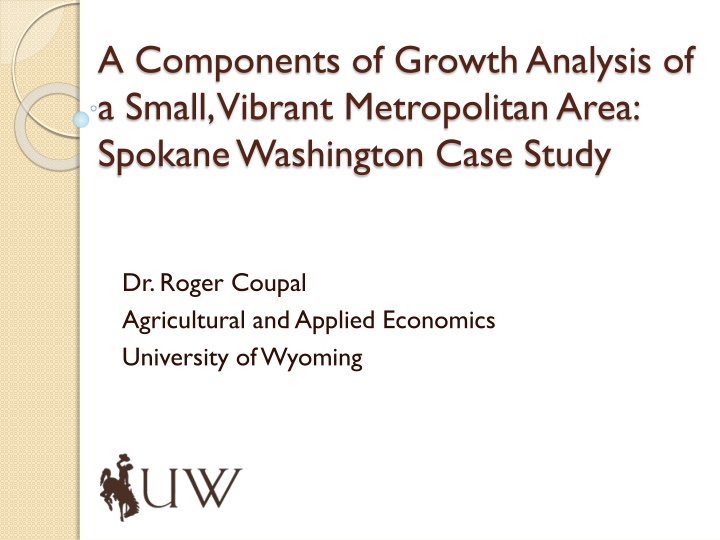
Growth Analysis of Spokane, Washington: Components and Trends
Explore the components of growth analysis in Spokane, Washington, including income approach frameworks, energy booms, job-to-population ratios, and industry mix components. Discover how different factors influence the area's economic development trends.
Download Presentation

Please find below an Image/Link to download the presentation.
The content on the website is provided AS IS for your information and personal use only. It may not be sold, licensed, or shared on other websites without obtaining consent from the author. If you encounter any issues during the download, it is possible that the publisher has removed the file from their server.
You are allowed to download the files provided on this website for personal or commercial use, subject to the condition that they are used lawfully. All files are the property of their respective owners.
The content on the website is provided AS IS for your information and personal use only. It may not be sold, licensed, or shared on other websites without obtaining consent from the author.
E N D
Presentation Transcript
A Components of Growth Analysis of a Small, Vibrant Metropolitan Area: Spokane Washington Case Study Dr. Roger Coupal Agricultural and Applied Economics University of Wyoming
Framework: Components of Income approach Based upon: Smith, G. (1996): Garnick, D.(1990) Components of Income approach: E/N = H/J + E/H + J/N TPI/N = E/N + P/N + T/N + IA/N N = Population TPI = Total personal income E = Earnings P = Property income T = Transfer payments IA = Income adjustments H = Hypothetical earnings J = Number of Jobs (full and part-time H/J = Industry mix component E/H = Differential Earnings Component J/N = job / population Ratio ?
Energy Booms High Tech Mfg bust Chart Energy Bust Y USE/J H/J E/J 50,000 Spokane Earnings / Job, Spokane Hypothetical Earnings / Job, and US Earnings / Job Tends to trend the nation but at a lower level. Do lower energy prices mean higher growth? Growth during the high tech growth but flat during the energy boom. Energy bust: an uptick. Chart 40,000 Y USE/J H/J E/J Y 50,000 30,000 40,000 Y 20,000 1970 1972 1974 1976 1978 1980 1982 1984 1986 1988 1990 1992 1994 1996 1998 2000 2002 2004 2006 2008 2010 year 30,000 20,000 1970 1972 1974 1976 1978 1980 1982 1984 1986 1988 1990 1992 1994 1996 1998 2000 2002 2004 2006 2008 2010 year
5/15/13 9:23 AM Chart Job to population ratio, Spokane and the United States Y 0.70 Generally increased except during the lead up to the current recession Spokane J/N tracked slightly higher since the mid-90 s As a pct of the national J/N USJ/N 0.65 0.60 0.55 Ratio 0.50 0.45 0.40 0.35 1970 1972 1974 1976 1978 1980 1982 1984 1986 1988 1990 year 1992 1994 1996 1998 2000 2002 2004 2006 2008 2010 Chart 110.0% Job to population ratio as a percent of the US ratio 105.0% Job to Pop Ratio 100.0% 95.0% 90.0% 1973 1978 1983 1988 1993 1998 2003 2008 year
Industry Mix Component of relative per capita income and compared with earnings per Job, Pct Change from the preceding year ? ? ? Summary of Fit RSquare RSquare Adj 0.568606 Root Mean Square Error 0.013718 Mean of Response 0.017351 Observations (or Sum Wgts) 42 0.58965 Residual by Predicted Plot Parameter Estimates Term Intercept IndMixGrth IndEarnGrth Estimate Std Error t Ratio 0.0025275 0.002962 0.031583 0.158376 0.5352067 0.082951 Prob>|t| 0.3986 0.8430 <.0001* 0.85 0.20 6.45
Job ratio component of relative per capita income growth Summary of Fit RSquare RSquare Adj Root Mean Square Error 0.013691 Mean of Response Observations (or Sum Wgts) 42 0.591299 0.57034 0.017351 Parameter Estimates Term Intercept DifEarnGrwth J/NGrwth Estimate 0.0138919 0.3862331 0.7684218 Std Error t Ratio 0.002226 0.146913 0.103109 Prob>|t| <.0001* 0.0122* <.0001* 6.24 2.63 7.45 ?
Differential Earnings Growth Component of Relative PCI, Spokane 5/15/13 10:07 AM Chart Y DifEarnGrwth PCPIGrth 0.10 0.05 Pct Change 0.00 -0.05 1970 1972 1974 1976 1978 1980 1982 1984 1986 1988 1990 year 1992 1994 1996 1998 2000 2002 2004 2006 2008 2010 Summary of Fit RSquare RSquare Adj Root Mean Square Error 0.018744 Mean of Response Observations (or Sum Wgts) 42 0.233941 0.194656 0.017351 Parameter Estimates Term Intercept DifEarnGrwth IndMixGrth Estimate Std Error t Ratio 0.0110054 0.003577 0.4417462 0.215804 0.7060462 0.208765 Prob>|t| 0.0038* 0.0474* 0.0016* 3.08 2.05 3.38 ?
t= m +fpcpit-1- pcpit-2 pcpi Model: AR(1) Model Summary DF 41 Sum of Squared Errors RSquare RSquare Adj MAPE MAE Stable : Invertible: 15881057.7 0.91296883 0.91084611 1.74134482 580.072929 Yes Yes Parameter Estimates Term Lag Estimate Std Error t Ratio Prob>|t| Constant AR1 Intercept 1 0.993 34896.543 0.009 4695.124 101.39 7.43 <.0001* <.0001* 254.408251 0 PCPI = f( IndMix, E/J, J /N, USJ /N) Summary of Fit RSquare RSquare Adj 0.640877 Analysis of Variance Parameter Estimates Term Intercept IndMixGrth E/JGrwth J/NGrwth USJ/N 0.675913 Estimate 0.0061186 -0.114912 0.554309 0.6939885 0.0075217 Std Error 0.022885 0.161848 0.144011 0.097906 0.042908 t Ratio 0.27 -0.71 3.85 7.09 0.18 Prob>|t| 0.7907 0.4822 0.0005* <.0001* 0.8618 ?
Conclusions and Discussion Slower growth in earnings per job than the national setting Continued divergence between national hypothetical and local earnings Less connection between the national and local conditions More reliance on growth factors (J/N, etc.) They type of national growth may or may not affect a metro area Methodological / Geographic considerations We don t know how other metro areas perform. What is perhaps more important is whether capital flows facilitate more startups. Firms within groups of like industries tend to cluster. What an economic development initiative would like is separate from what it can actually accomplish, through no fault of its own. Jeffrey City, Wy: Boeing branch plant location? Vet School, Medical School? Anything, please!!
